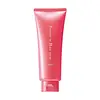What's inside
What's inside
 Key Ingredients
Key Ingredients

 Benefits
Benefits

 Concerns
Concerns

 Ingredients Side-by-side
Ingredients Side-by-side

Water
Skin ConditioningGlycerin
HumectantCetearyl Alcohol
EmollientDistarch Phosphate
AbsorbentQuaternium-87
CleansingDimethicone
EmollientCI 60730
Cosmetic ColorantCI 60725
Cosmetic ColorantLactic Acid
BufferingSodium Hyaluronate
HumectantPhenoxyethanol
PreservativeSteareth-6
EmulsifyingAcetic Acid
BufferingPEG-150/Decyl Alcohol/Smdi Copolymer
PEG-100 Stearate
Behentrimonium Chloride
PreservativeTrideceth-10
CleansingTrideceth-3
EmulsifyingChlorhexidine Digluconate
AntimicrobialPropylene Glycol
HumectantAmodimethicone
Isopropyl Alcohol
SolventParfum
MaskingWater, Glycerin, Cetearyl Alcohol, Distarch Phosphate, Quaternium-87, Dimethicone, CI 60730, CI 60725, Lactic Acid, Sodium Hyaluronate, Phenoxyethanol, Steareth-6, Acetic Acid, PEG-150/Decyl Alcohol/Smdi Copolymer, PEG-100 Stearate, Behentrimonium Chloride, Trideceth-10, Trideceth-3, Chlorhexidine Digluconate, Propylene Glycol, Amodimethicone, Isopropyl Alcohol, Parfum
Water
Skin ConditioningGlycerin
HumectantCetearyl Alcohol
EmollientDimethicone
EmollientBehentrimonium Chloride
PreservativeSorbitol
HumectantIsopentyldiol
HumectantHydrogenated Raspberry Seed Oil
EmollientPPG-3 Caprylyl Ether
SolventBis-Ethoxydiglycol Cyclohexane 1,4-Dicarboxylate
EmollientIsostearic Acid
CleansingIsostearoyl Hydrolyzed Collagen
CleansingIsostearoyl Hydrolyzed Silk
Skin ConditioningSphingolipids
EmollientHydroxypropyltrimonium Hyaluronate
Glycolipids
Skin ConditioningButylene Glycol
HumectantHydrolyzed Soy Protein
HumectantGluconolactone
Skin ConditioningStearamidopropyl Dimethylamine
EmulsifyingPentylene Glycol
Skin ConditioningIsomerized Safflower Acid
Skin ConditioningAmodimethicone
Bis-Isobutyl PEG/PPG-10/7/Dimethicone Copolymer
EmulsifyingDicocodimonium Chloride
EmulsifyingSteartrimonium Chloride
PreservativePhytosteryl Isostearyl Dimer Dilinoleate
EmollientIsopropyl Alcohol
SolventPhenoxyethanol
PreservativeTocopherol
AntioxidantCitric Acid
BufferingArginine
MaskingPEG-90m
Emulsion StabilisingWater, Glycerin, Cetearyl Alcohol, Dimethicone, Behentrimonium Chloride, Sorbitol, Isopentyldiol, Hydrogenated Raspberry Seed Oil, PPG-3 Caprylyl Ether, Bis-Ethoxydiglycol Cyclohexane 1,4-Dicarboxylate, Isostearic Acid, Isostearoyl Hydrolyzed Collagen, Isostearoyl Hydrolyzed Silk, Sphingolipids, Hydroxypropyltrimonium Hyaluronate, Glycolipids, Butylene Glycol, Hydrolyzed Soy Protein, Gluconolactone, Stearamidopropyl Dimethylamine, Pentylene Glycol, Isomerized Safflower Acid, Amodimethicone, Bis-Isobutyl PEG/PPG-10/7/Dimethicone Copolymer, Dicocodimonium Chloride, Steartrimonium Chloride, Phytosteryl Isostearyl Dimer Dilinoleate, Isopropyl Alcohol, Phenoxyethanol, Tocopherol, Citric Acid, Arginine, PEG-90m
Ingredients Explained
These ingredients are found in both products.
Ingredients higher up in an ingredient list are typically present in a larger amount.
This water-soluble silicone is used for its hydrating and softening properties. It is used to add a silky feel to skincare products and has great benefits for haircare.
In haircare, this ingredient:
- Adds shine
- Protects color
- Offers thermal protection
- Boosts hair strength
- Does not build up as easily
This ingredient is a preservative and often used for it's anti-static properties. You'll most likely see this ingredient in hair conditioners.
It does not cause irritation or sensitization in leave-on products at 1-5%.
Cetearyl alcohol is a mixture of two fatty alcohols: cetyl alcohol and stearyl alcohol. It is mainly used as an emulsifier. Emulsifiers help prevent the separation of oils and products. Due to its composition, it can also be used to thicken a product or help create foam.
Cetearyl alcohol is an emollient. Emollients help soothe and hydrate the skin by trapping moisture.
Studies show Cetearyl alcohol is non-toxic and non-irritating. The FDA allows products labeled "alcohol-free" to have fatty alcohols.
This ingredient is usually derived from plant oils such as palm, vegetable, or coconut oils. There is debate on whether this ingredient will cause acne.
Due to the fatty acid base, this ingredient may not be Malassezia folliculitis safe.
Learn more about Cetearyl AlcoholDimethicone is a type of synthetic silicone created from natural materials such as quartz.
What it does:
Dimethicone comes in different viscosities:
Depending on the viscosity, dimethicone has different properties.
Ingredients lists don't always show which type is used, so we recommend reaching out to the brand if you have questions about the viscosity.
This ingredient is unlikely to cause irritation because it does not get absorbed into skin. However, people with silicone allergies should be careful about using this ingredient.
Note: Dimethicone may contribute to pilling. This is because it is not oil or water soluble, so pilling may occur when layered with products. When mixed with heavy oils in a formula, the outcome is also quite greasy.
Learn more about DimethiconeGlycerin is already naturally found in your skin. It helps moisturize and protect your skin.
A study from 2016 found glycerin to be more effective as a humectant than AHAs and hyaluronic acid.
As a humectant, it helps the skin stay hydrated by pulling moisture to your skin. The low molecular weight of glycerin allows it to pull moisture into the deeper layers of your skin.
Hydrated skin improves your skin barrier; Your skin barrier helps protect against irritants and bacteria.
Glycerin has also been found to have antimicrobial and antiviral properties. Due to these properties, glycerin is often used in wound and burn treatments.
In cosmetics, glycerin is usually derived from plants such as soybean or palm. However, it can also be sourced from animals, such as tallow or animal fat.
This ingredient is organic, colorless, odorless, and non-toxic.
Glycerin is the name for this ingredient in American English. British English uses Glycerol/Glycerine.
Learn more about GlycerinIsopropyl Alcohol is more commonly known as rubbing alcohol. It is most commonly used as a solvent, meaning it helps other ingredients dissolve.
This ingredient is an astringent alcohol. Astringent alcohols may also irritate skin as they high amounts may strip away your skin's natural oils.
Other types of astringent alcohols include:
According to the National Rosacea Society based in the US, you should be mindful of products with these alcohols in the top half of ingredients.
Any type of sanitizing product will have high amounts of alcohol to help kill bacteria and viruses.
Learn more about Isopropyl AlcoholPhenoxyethanol is a preservative that has germicide, antimicrobial, and aromatic properties. Studies show that phenoxyethanol can prevent microbial growth. By itself, it has a scent that is similar to that of a rose.
It's often used in formulations along with Caprylyl Glycol to preserve the shelf life of products.
Water. It's the most common cosmetic ingredient of all. You'll usually see it at the top of ingredient lists, meaning that it makes up the largest part of the product.
So why is it so popular? Water most often acts as a solvent - this means that it helps dissolve other ingredients into the formulation.
You'll also recognize water as that liquid we all need to stay alive. If you see this, drink a glass of water. Stay hydrated!
Learn more about Water